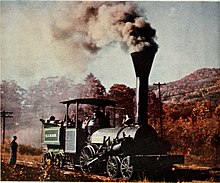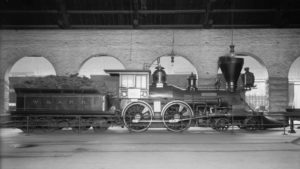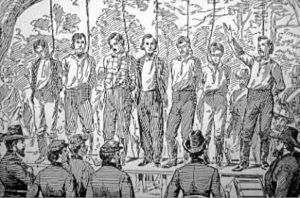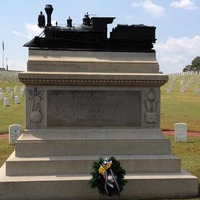Andrews’ plan was to travel as normal as possible to avoid detection, particularly through stations, so he went at a normal speed to keep on the original time frame and stopped only in between stations to cut telegraph wire or obstruct the track with railroad ties. The Raiders ran into trouble in their plans to destroy the tracks because they had not been able to bring the necessary tools with them, but they did pull down the wires using the train’s momentum.
Fuller and his men were on their own in chasing Andrew’s Raiders. Once they reached the next station, they borrowed a hand car (along with two other men joining them) to continue the chase. This was a pole cart where workers used long poles to move themselves along, not a “seesaw car” as depicted in the famous Disney film. Meanwhile, the General continued its way north past Allatoona, Etowah, Cass Station, and approached Kingston, a larger junction station.
Just across the Etowah River, Fuller spotted the Yonah, a rusty switch engine owned by Cooper’s Iron Works. Seizing the little locomotive, Fuller and his comrades chuffed several miles to Kingston, where they found southbound trains blocking their path. They had to pursue Andrews on foot once again. Shortly, thereafter, Fuller met W&A Engine No. 49, the Texas, pulling a southbound train. The Texas uncoupled its cars on a sidetrack and then, with the engine running in reverse, Fuller resumed the chase.

Replica of the Lafayette, which portrayed the Yonah, during filming of The Great Locomotive Chase
Meanwhile, Andrews had stopped the General near Resaca, GA, he hoped to burn the Oostanaula River rail bridge. While he was stopped, he spotted the Texas coming up quickly. Andrews hastily abandoned the undamaged bridge and the General sped northward into Whitfield County.
Around noon on April 12, 1862, Andrews and his raiders crossed into Whitfield County aboard the General. The raiders on the General needed to get well ahead of their pursuers before reaching Dalton and continued to drop crossties and firewood on the tracks in an effort to slow the Texas’ advance. At one point they stopped and tried to remove a rail, but the spikes held and their efforts failed. The whistle of the Texas was heard in the distance and they dashed onto Dalton. Once again Andrews had a respectable lead in the chase. The General rushed through the passenger shed that covered both tracks, past the Dalton Depot, and past the Chester House, where they had just dined the night before. Meanwhile, the Texas was slowing down as it approached the Dalton Depot platform. Here Fuller dropped off 17-year-old Edward Henderson and instructed him to telegraph Confederate General Leadbetter in Chattanooga about the situation.
“My train was captured this A.M. at Big Shanty evidently by Federal soldiers in disguise. They are making rapidly for Chattanooga, possibly with the idea of burning the railroad bridges in their rear. If I do not capture them in the meantime see that they do pass Chattanooga.” -William A. Fuller
The wire was cut by Andrews and his men but not before enough of the message made it through to alert the authorities in Chattanooga. Fuller pressed on towards Tunnel Hill determined as ever to capture Andrews. Alerted to the stolen engine, General Leadbetter sent a Confederate force to meet the Raiders eleven miles from the city; they tore up the track and waited for the General.

The General locomotive (Photo courtesy the Library of Congress)
The General steamed through Buzzard’s Roost and continued north towards the Western & Atlantic railroad tunnel. Andrews and his men sped through the tunnel as quickly as the General’s steam pressure would allow and then pressed on towards Ringgold. At this point the Raiders were struggling. Fuller was hard on their heels with the Texas, they were running out of fuel, and, unbeknownst to them, there was now a Confederate force waiting for them. Fuller approached the tunnel with caution fearing a missing rail or some other obstruction awaited them in the dark passage. Finding the tunnel clear, Fuller ordered his engineer to open the throttle and they began to catch up to the General once again.
When the General reached Ringgold, the chase had slowed to a crawl. Around 1:00 pm, the last of the steam gave out and the General came to a halt. Andrews ordered his men to scatter and flee into the rain-soaked woods while Fuller triumphantly reclaimed its engine and towed it back to safety at Ringgold. Fuller had followed his engine the entire way, first on foot, then with the hand car, and then with three successive engines, ending with the Texas which chased the General for 48 miles backwards. The Great Locomotive Chase had ended.
Within a week all of the raiders were rounded up. Eventually, Andrews and his men were deposited at the jail in Chattanooga. The Southern press began to sensationalize the story of the “engine thieves” and almost immediately the legend was born. The Atlanta Southern Confederacy, for example, proclaimed the Andrews’ Raid as “the most extraordinary and astounding adventure of the war.” In the end, Andrews and 7 of his companions were hanged as spies. The rest either escaped or were later exchanged for Confederate prisoners. Most of the raiders were eventually awarded the first ever Medals of Honor, but Andrews was not among those to receive them. He was a civilian and therefore ineligible.

The hangings of soldiers Marion A. Ross, George D. Wilson, Charles P. Shadrach, John M. Scott, Samuel Slavens, Samuel Robertson and civilian William Campbell, occurred near Oakland Cemetery.
Overall Andrews’ and his raiders mission failed, they did not achieve anything they set out to accomplish. Their objective of wrecking the Western & Atlantic railway was a dismal failure and 8 of them, Andrews included, lost their lives. Yet the Great Locomotive Chase is one of the most widely known events of the American Civil War. Made even more famous by the Disney movie with the same name starring Fess Parker. Fess Parker was already popular by starring as Davy Crockett.

This monument built in 1890 with a replica of “The General” locomotive honors the men who conducted the raid.
Such an interesting and exciting adventure happened right here in our town, and you can even walk through the very Tunnel that Andrews and Fuller went through. Here at the Tunnel Hill Heritage Center we love showing visitors around this historic site and telling the tale of Andrews and his brave raiders. We would love to have you visit and see the famous location up close!




